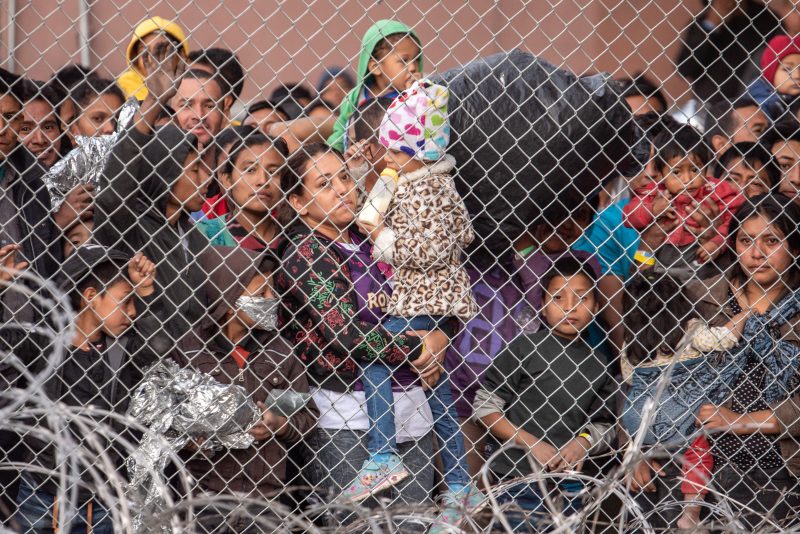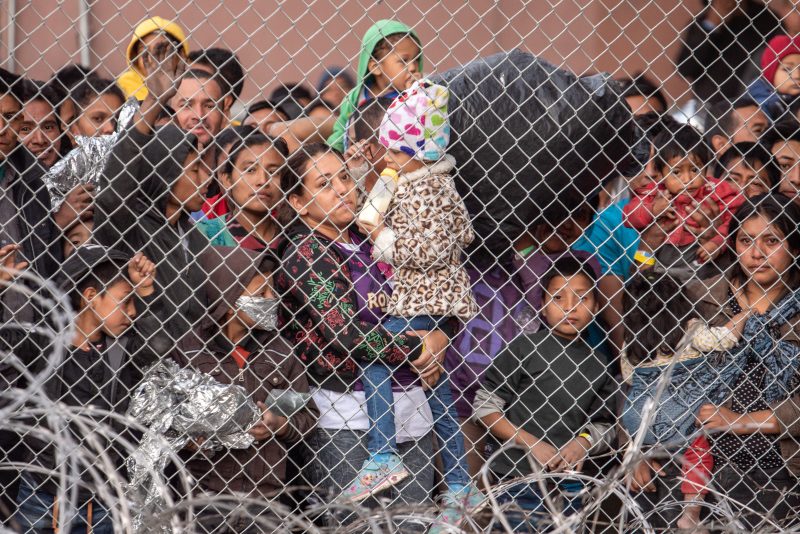
Faced with a surge of migrant families at the U.S.-Mexico border in 2018 and 2019, Donald Trump’s White House discussed ways to more aggressively deploy the resources and the might of the U.S. military.
Aides and officials spoke privately about detaining migrants on military bases and flying them out of the country on military planes — ideas that the Pentagon headed off. Throughout his presidency, Trump himself would frequently demand to send troops to the border and catch people crossing.
“He was obsessed with having the military involved,” said a former senior administration official, who, like others, spoke on the condition of anonymity to describe private discussions.
That approach and unfinished business have taken on renewed significance and urgency as the country confronts another migrant crisis on the U.S.-Mexico border, and as Trump closes in on the Republican presidential nomination. The former president is making immigration a core campaign theme, promoting a proposal for an unprecedented deportation effort if he is returned to power.
Trump pledges that as president he would immediately launch “the largest domestic deportation operation in American history.” As a model, he points to an Eisenhower-era program known as “Operation Wetback,” using a derogatory slur for Mexican migrants. The operation used military tactics to round up and remove migrant workers, sometimes transporting them in dangerous conditions that led to some deaths. Former administration officials and policy experts said staging an even larger operation today would face a bottleneck in detention space — a problem that Trump adviser Stephen Miller and other allies have proposed addressing by building mass deportation camps.
“Americans can expect that immediately upon President Trump’s return to the Oval Office, he will restore all of his prior policies, implement brand new crackdowns that will send shock waves to all the world’s criminal smugglers, and marshal every federal and state power necessary to institute the largest deportation operation in American history,” said Trump campaign spokeswoman Karoline Leavitt in a statement. She added that undocumented immigrants “should not get comfortable because very soon they will be going home.”
Trump has made similar promises and has used inflammatory smears since his 2016 campaign. But he, his aides and allies say a second turn in office would be more effective in operating the levers of the federal bureaucracy and less vulnerable to internal resistance. During his term, former officials said, Trump learned to install more officials at the Department of Homeland Security who would carry out his orders instead of trying to curb his impulses.
Throughout his current campaign, the former president has exerted his influence on the immigration policy debate on several fronts. He pressured congressional Republicans to reject a bipartisan compromise to expand enforcement funding and powers, arguing that it would give the Democrats a political victory and that it was not restrictive enough. He has also escalated his use of dehumanizing language to describe migrants, accusing them of “poisoning the blood of our country” and calling the record unauthorized border crossings an “invasion,” an “open wound” and a source of imminent terrorist attacks.
But his deportation proposal is one part of his emerging platform that experts, current and former government officials and others described as especially alarming, impractical and prone to significant legal and logistical hurdles.
“You’re talking about officers in tactical gear going into communities, being videotaped in the streets, putting kids in car seats, carrying baby formula. Then what do you do with those families?” said Jason Houser, U.S. Immigration and Customs Enforcement’s chief of staff from January 2022 until March 2023. “Are you going to go into neighborhoods in Philly, New York, Baltimore and start tugging people out of communities? That’s what they want. It puts law enforcement and the communities at risk.”
Reflecting on the ideas Trump and his team discussed during his presidency, Houser said, “Their ideas were psychotic.”
Trump’s aides are encouraged by polls showing voters prioritizing immigration and trusting him more than President Biden on the issue. But there is some disagreement in his circles on the specifics.
While advisers agree on border security, building a wall on the southern border and deporting migrants who have committed crimes after entering the country as winning political issues, one adviser expressed concern that promising to deport massive numbers of people who haven’t been convicted of a crime could hurt Trump in a general election campaign. Trump’s language and proposals are already under heavy criticism from the Biden campaign, as well as pro-immigration and civil liberties groups.
“Trump is following the 20th century dictator’s playbook of dehumanizing vulnerable groups in order to isolate them and justify cruelty by the state,” Genevieve Nadeau, a former DHS lawyer, said in a report by the nonpartisan organization Protect Democracy. “He’s backing up his rhetoric by threatening to invoke extreme and novel legal tools to effectuate an agenda of inhumanity on a scale we haven’t seen for generations. We should expect him to follow through on his pledges.”
The Trump campaign has also said he would sign an executive order on his first day in office to withhold passports, Social Security numbers and other government benefits from children of undocumented immigrants born in the United States. The idea of challenging the 14th Amendment’s guarantee of birthright citizenship would be sure to draw a court challenge. The proposal has been raised by Trump and Miller before, but the specific promise of an executive order indicated the campaign has put further effort into fleshing it out.
Some in the Trump campaign have tried to tamp down talk of mass deportations and have become frustrated with some outside allies, the Trump adviser said. But another person close to the campaign said Trump and his team remain in touch with Miller, who has described “large-scale raids” and “throughput facilities.” Trump advisers view Miller as the leading authority on “America First” immigration policy, and he is widely expected to reenter the West Wing if Trump wins in November.
“I don’t care what the hell happens in this world,” Miller said on a Feb. 5 podcast interview with right-wing activist Charlie Kirk. “If President Trump gets reelected, the border’s going to be sealed, the military will be deployed, the National Guard will be activated, and the illegals are going home.”
Republicans frustrated with Biden have increasingly promoted the idea of militarized immigration enforcement. In Texas, Gov. Greg Abbott (R) has deployed thousands of National Guard soldiers to stop crossings along the Rio Grande, where he announced plans Friday to build a military base to house the troops.
Trump and his campaign have offered few details about how he would implement his deportation operation, other than to “use all necessary federal, state, local and military resources.”
The pool of potential deportees is large. There are about 11 million immigrants in the United States without legal status, according to the most recent estimates. Nearly 7 million of those are known to ICE, which maintains a vast database of people eligible for deportation whose asylum claims and immigration cases are still pending.
A smaller subset of that caseload — about 1.3 million people — remain in the United States despite having received a deportation order from an immigration judge. These potential deportees, if taken into custody, are the easiest for the government to send home, because they have already received due process. But the government often doesn’t know where they are.
Beyond those challenges, there are other major logistical and operational obstacles to the kind of mass deportations Trump has promised. The first is available personnel: ICE only has about 6,000 deportation officers nationwide. The amount of time it takes to recruit, hire, screen and train a new deportation officer is about two years, according to current and former ICE officials.
Detention space is also squeezed. The Biden administration is using about 38,000 beds at immigration jails and other facilities that hold migrants awaiting deportation. During the Trump years, the number exceeded 50,000, but never reached the kinds of capacity levels necessary for the kind of mega-deportation system Trump envisions.
Some ICE officials said the agency could find more available beds in county jails. But Trump surrogates have gone further, suggesting they would put migrants in “camps” or “tents.”
“So you go around the country arresting illegal immigrants in large-scale raids, you have to have somewhere to put them,” Miller said in a November podcast interview with Kirk. “So you create this efficiency by having these standing facilities where planes are moving off the runway constantly — probably military aircraft, some existing DHS assets — and that’s how you’re able to scale.”
Miller also suggested using National Guard troops, state police and other federal law enforcement agencies as force multipliers, even sending National Guard troops from Republican-led states into neighboring states governed by Democrats. “If you’re going to go into an unfriendly state like Maryland, well, they would just be Virginia doing the arrest in Maryland,” he said in the November podcast interview.
Such street-level roundups are so resource-intensive that many ICE officials view them as impractical. The operations require officers to locate migrants and surveil them to determine a safe opportunity to make an arrest. Such arrests often depend on the cooperation of local police.
“The most crucial part of any law enforcement effort is not to undermine popular support for that effort, and that means doing it legally, doing it respectfully and doing it properly,” said Andrew Arthur, a former immigration judge who is now at the Center for Immigration Studies, which seeks tighter restrictions.
To arrest and deport families with children, the preparations are even more time-consuming. An operation targeting 20 to 30 families for arrest takes two to three weeks of planning, said Houser, the former ICE chief of staff. For ICE to reach a target of 300,000 to 500,000 deportations per year — a far more modest goal than Trump’s — Houser said the agency would need two to three times as many deportation officers as ICE has.
“You’re talking about building a major logistics apparatus that would still have to meet court and legal requirements for health care and child care,” he said.
ICE officers and staff are burned out by the pace and intensity of their work over the past several years, according to a veteran DHS official who was not authorized to speak to reporters. For other law enforcement agencies, the drain on their resources would come at the expense of other legitimate priorities, the former DHS official said, and the operation would have to be continuous to deter new arrivals.
“It feels shortsighted, stupid and an enormous waste of money,” the official said.
Another problem is so-called “recalcitrant countries” that limit or refuse to take back deportees. Nations such as Venezuela and Cuba are already under U.S. economic sanctions, leaving Washington with reduced leverage to compel them to take more deportation flights.
Even other nations that remain U.S. allies in Latin America set conditions on the number of flights and deportees they’re willing to accept. Passenger manifests have to be sent several days in advance. It’s not as simple as loading hundreds of people into a military transport plane and dropping them off wherever the president wants.
A former senior administration official said Trump would be emboldened in a second term and insist on moving faster than his first administration did. The former president has repeatedly suggested he would act as a “dictator” on “day one” to close the border — sometimes adding that he made this comment in jest.
“We will do that immediately,” Trump said in a campaign video last year. “This invasion will not stand.”
Trump’s and Miller’s determination to carry out mass deportations in a second term grew out of frustration with setbacks to their plans while Trump was in power.
In Trump’s first month as president, in 2017, a draft memo obtained by the Associated Press proposed deploying as many as 100,000 National Guard troops to arrest undocumented immigrants throughout the interior of the country. The memo was never implemented, but Trump did sign an executive order directing ICE to detain more unauthorized immigrants, including pregnant women and people without criminal records.
Trump pledged to immediately deport 2 million to 3 million people after his 2016 win but never came close to hitting those targets. At his administration’s high-water mark in 2019, ICE carried out 267,258 deportations and returns, Department of Homeland Security data show.
Trump officials likened the approach to “taking the shackles off,” but it generated a backlash that drove more cities and jurisdictions to adopt sanctuary policies limiting their cooperation with ICE. ICE officials have long preferred to take people into custody from a secure setting such as a jail to avoid the complex planning and adverse publicity of arrests in homes, workplaces or streets.
As the number of people in ICE custody jumped 22 percent in Trump’s first two years, the DHS inspector general uncovered “egregious violations of detention standards,” including inadequate medical care, expired food, lack of recreation, moldy bathrooms and inadequate clothing and hygiene supplies. A separate inspector general’s investigation found “dangerous overcrowding” in an El Paso facility, where a cell built for 25 people held 155.
In June 2018, reporters and human rights activists toured a facility in McAllen, Tex., where children slept under foil sheets surrounded by chain-link fencing, after DHS acknowledged separating children from their parents at the border. Public outrage over an audio clip of a sobbing child forced Trump to halt the practice. DHS later identified 4,227 separated children, 3,147 of whom were reunited with their parent as of November 2023.
Asked in 2023 whether he might reimpose family separation as president, Trump declined to rule it out and defended the policy. “I know it sounds harsh,” he said in a CNN town hall. “When you say to a family that if you come we’re going to break you up, they don’t come. And we can’t afford to have any more.”
In 2019, Trump ordered pre-dawn raids targeting 2,000 families in 10 cities who had received deportation orders, over concerns from top DHS officials about lack of preparation and the effect on children. The administration also changed immigration enforcement rules to expedite deportations of people who had been in the country for less than two years, making it possible to remove them without a hearing in front of an immigration judge.
“You think other countries have judges that give them trials?” Trump said in public remarks in 2018.
As the president’s top adviser on immigration matters, Miller advocated for invoking the Insurrection Act to mobilize the Department of Defense, according to the former officials. Pentagon officials balked at the idea of using military bases and planes, current and former officials recalled, citing concerns of getting mired in an open-ended commitment or compromising troop readiness.
The president himself would often demand to send troops to block the border, according to the former officials. Aides would explain to Trump the lack of budget or legal authority to use the military for immigration, including a law against using the military for domestic law enforcement, according to former national security adviser John Bolton.
“He couldn’t care less,” Bolton said.
Trump was generally more focused on his signature campaign promise to build a wall on the border with Mexico, according to former officials.
“The pressure from the White House was always more about the wall,” a former senior DHS official said. “We didn’t really get significant pressure in the first term on deportations.”
Still, Trump would often say he wanted more deportations and listened to immigration hard-liners, led by Miller, a former senior administration official said. The biggest deterrent, the official said, was limited space to house people while they were awaiting a court proceeding and not enough judges to move the proceedings quickly.
“Every time the hard-liners would say, ‘we need to start arresting them,’ I would say — as I said 50 times — in order to do this, we have to make all these things happen. That was the end of any conversation,” the former senior administration official said. “It’s not an overnight thing.”
Miller reached the conclusion that aggressive immigration enforcement had to be implemented as quickly as possible, without losing time by considering litigation risks, a former DHS official said. During Trump’s first term, immigration advocates and civil liberties groups repeatedly succeeded in halting or narrowing Trump’s policies through court challenges, and he could face similar challenges to a mass deportation operation.
Trump has specifically cited the Eisenhower example and defended its legacy. When CNN’s Jake Tapper noted in 2016 that many people considered it a “shameful chapter in American history,” Trump responded: “Some people do, and some people think it was a very effective chapter. … It was very successful, everyone said. So I mean, that’s the way it is.”
Press reports described the operation in the summer of 1954 as “an all-out war” with a wire-fenced “concentration camp” from which Mexicans were “herded aboard trains.” Others were forcibly marched through miles of rattlesnake-infested deserts or had their heads shaved — ostensibly for hygienic reasons but widely viewed as humiliating, according to historian Juan R. Garcia’s definitive book on the subject. The Red Cross intervened after many braceros, or temporary agricultural workers and laborers, were stranded in the desert, and 88 died of sunstroke, according to Columbia University historian Mae Ngai.
The deportations also used planes, buses and ships, including one built for up to 90 people that was crowded with 500, leading one lawmaker to compare it to a “penal ship.” The use of ships stopped after seven migrants drowned while trying to escape.
The Eisenhower effort “was a one-off,” Ngai said. Trump and his allies “are trying to figure out a way to do that in a sustained way.”

